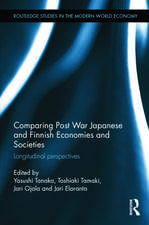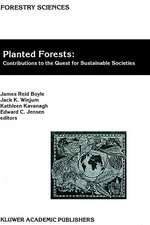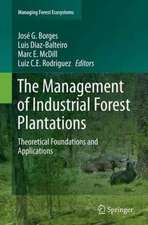The Evolution of Global Paper Industry 1800¬–2050: A Comparative Analysis: World Forests, cartea 17
Editat de Juha-Antti Lamberg, Jari Ojala, Mirva Peltoniemi, Timo Särkkäen Limba Engleză Hardback – 21 dec 2012
| Toate formatele și edițiile | Preț | Express |
|---|---|---|
| Paperback (1) | 1547.93 lei 43-57 zile | |
| SPRINGER NETHERLANDS – 29 ian 2015 | 1547.93 lei 43-57 zile | |
| Hardback (1) | 1559.80 lei 43-57 zile | |
| SPRINGER NETHERLANDS – 21 dec 2012 | 1559.80 lei 43-57 zile |
Din seria World Forests
- 15%
 Preț: 646.43 lei
Preț: 646.43 lei - 15%
 Preț: 643.48 lei
Preț: 643.48 lei - 18%
 Preț: 1235.43 lei
Preț: 1235.43 lei - 18%
 Preț: 1225.94 lei
Preț: 1225.94 lei - 15%
 Preț: 631.53 lei
Preț: 631.53 lei - 18%
 Preț: 1233.37 lei
Preț: 1233.37 lei - 18%
 Preț: 947.35 lei
Preț: 947.35 lei - 18%
 Preț: 943.57 lei
Preț: 943.57 lei - 18%
 Preț: 946.41 lei
Preț: 946.41 lei - 18%
 Preț: 953.35 lei
Preț: 953.35 lei - 15%
 Preț: 644.95 lei
Preț: 644.95 lei - 15%
 Preț: 640.06 lei
Preț: 640.06 lei - 15%
 Preț: 645.60 lei
Preț: 645.60 lei - 18%
 Preț: 1223.55 lei
Preț: 1223.55 lei - 18%
 Preț: 730.35 lei
Preț: 730.35 lei - 18%
 Preț: 1107.56 lei
Preț: 1107.56 lei - 18%
 Preț: 1240.30 lei
Preț: 1240.30 lei - 18%
 Preț: 952.40 lei
Preț: 952.40 lei - 20%
 Preț: 552.12 lei
Preț: 552.12 lei - 18%
 Preț: 954.45 lei
Preț: 954.45 lei - 24%
 Preț: 779.23 lei
Preț: 779.23 lei - 24%
 Preț: 1058.44 lei
Preț: 1058.44 lei - 18%
 Preț: 943.57 lei
Preț: 943.57 lei
Preț: 1559.80 lei
Preț vechi: 1902.19 lei
-18% Nou
Puncte Express: 2340
Preț estimativ în valută:
298.47€ • 312.41$ • 248.42£
298.47€ • 312.41$ • 248.42£
Carte tipărită la comandă
Livrare economică 31 martie-14 aprilie
Preluare comenzi: 021 569.72.76
Specificații
ISBN-13: 9789400754300
ISBN-10: 9400754302
Pagini: 388
Ilustrații: X, 378 p.
Dimensiuni: 155 x 235 x 26 mm
Greutate: 0.89 kg
Ediția:2012
Editura: SPRINGER NETHERLANDS
Colecția Springer
Seria World Forests
Locul publicării:Dordrecht, Netherlands
ISBN-10: 9400754302
Pagini: 388
Ilustrații: X, 378 p.
Dimensiuni: 155 x 235 x 26 mm
Greutate: 0.89 kg
Ediția:2012
Editura: SPRINGER NETHERLANDS
Colecția Springer
Seria World Forests
Locul publicării:Dordrecht, Netherlands
Public țintă
GraduateCuprins
Preface.- List of Contributors.- 1. Research on Evolution and the Global History of Pulp and Paper Industry: An Introduction.- 2. The Evolution of Pulp and Paper Industries in Finland, Sweden and Norway 1800-2005.- 3. Waves of Technological Innovation: The Evolution of the US Pulp and Paper Industry, 1860-2000.- 4. The Paper Industry in Germany, 1800-2000.- 5. An Accomplished History, An Uncertain Future: Canada’s Pulp and Paper Industry Since the Early 1800s.- 6. From the Non-European Tradition to a Variation on the Japanese Competitiveness Model: The Modern Japanese Paper Industry Since the 1870s.- 7. The British Paper Industry, 1800-2000.- 8. The Paper and Board Industry in the Netherlands, 1800-2000.- 9. Is there a Southern European model? Development of the Pulp and Paper Industry in Italy, Spain and Portugal.- 10. The South American Pulp and Paper Industry: The Cases Brazil, Chile and Uruguay.- 11. The Pulp and Paper Industry Evolution in Russia: A Road of Many Transitions.- 12. Global Market for Paper Products: 2006-2050.- 13. The Evolution of the Global Paper Industry: Concluding Remarks.
Textul de pe ultima copertă
Since the birth of the mechanised paper industry in early nineteenth century Europe, the prospects of the global paper industry have changed dramatically. The relative importance of western paper markets has diminished due to declining prices, relative scarcity of cheap raw materials and high energy and labour costs. The increased demand for paper and paper products of all kinds in the rapidly developing BRIC countries has moved the centre of industrial activity from Europe and North America to Asia and South America.
This book presents an historical analysis of the global paper industry evolution from a comparative perspective. At the centre are 16 producing countries (Finland, Sweden, Norway, the USA, Germany, Canada, Japan, the UK, the Netherlands, Italy, Spain, Portugal, Chile, Brazil, Uruguay and Russia). A comparative study of the paper industry evolution can achieve the following important research objectives. First, we can identify the country specific historical features of paper industry evolution and compare them to the general business trends explicable by existing theoretical knowledge. Second, we can identify and isolate the factors causing both the rise and fall of industrial populations. Third, a shared research agenda can produce an intensive analysis of global industry dynamics. Finally, an extended research period of 250 years can identify what is truly unique in the paper industry evolution and the extent to which it took the same path as other important manufacturing industries.
This book presents an historical analysis of the global paper industry evolution from a comparative perspective. At the centre are 16 producing countries (Finland, Sweden, Norway, the USA, Germany, Canada, Japan, the UK, the Netherlands, Italy, Spain, Portugal, Chile, Brazil, Uruguay and Russia). A comparative study of the paper industry evolution can achieve the following important research objectives. First, we can identify the country specific historical features of paper industry evolution and compare them to the general business trends explicable by existing theoretical knowledge. Second, we can identify and isolate the factors causing both the rise and fall of industrial populations. Third, a shared research agenda can produce an intensive analysis of global industry dynamics. Finally, an extended research period of 250 years can identify what is truly unique in the paper industry evolution and the extent to which it took the same path as other important manufacturing industries.
Caracteristici
16 producing countries are included in the book Analyses of the evolution of global paper industry and its future prospects An extended research period of 250 years





















